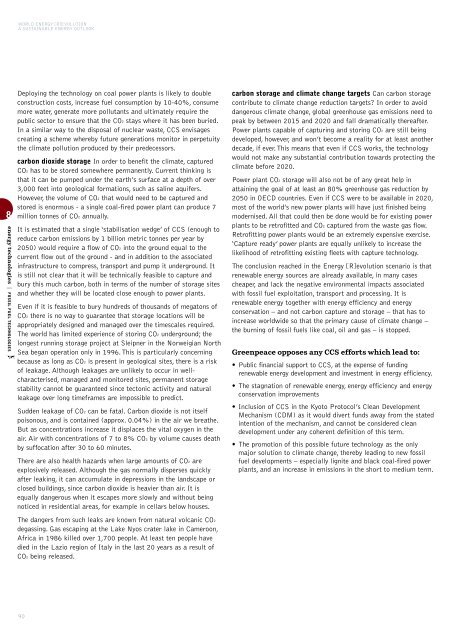download the mexico energy revolution scenario
download the mexico energy revolution scenario
download the mexico energy revolution scenario
Create successful ePaper yourself
Turn your PDF publications into a flip-book with our unique Google optimized e-Paper software.
WORLD ENERGY [R]EVOLUTION<br />
A SUSTAINABLE ENERGY OUTLOOK<br />
8<br />
<strong>energy</strong> technologies | FOSSIL FUEL TECHNOLOGIES<br />
Deploying <strong>the</strong> technology on coal power plants is likely to double<br />
construction costs, increase fuel consumption by 10-40%, consume<br />
more water, generate more pollutants and ultimately require <strong>the</strong><br />
public sector to ensure that <strong>the</strong> CO2 stays where it has been buried.<br />
In a similar way to <strong>the</strong> disposal of nuclear waste, CCS envisages<br />
creating a scheme whereby future generations monitor in perpetuity<br />
<strong>the</strong> climate pollution produced by <strong>the</strong>ir predecessors.<br />
carbon dioxide storage In order to benefit <strong>the</strong> climate, captured<br />
CO2 has to be stored somewhere permanently. Current thinking is<br />
that it can be pumped under <strong>the</strong> earth’s surface at a depth of over<br />
3,000 feet into geological formations, such as saline aquifers.<br />
However, <strong>the</strong> volume of CO2 that would need to be captured and<br />
stored is enormous - a single coal-fired power plant can produce 7<br />
million tonnes of CO2 annually.<br />
It is estimated that a single ‘stabilisation wedge’ of CCS (enough to<br />
reduce carbon emissions by 1 billion metric tonnes per year by<br />
2050) would require a flow of CO2 into <strong>the</strong> ground equal to <strong>the</strong><br />
current flow out of <strong>the</strong> ground - and in addition to <strong>the</strong> associated<br />
infrastructure to compress, transport and pump it underground. It<br />
is still not clear that it will be technically feasible to capture and<br />
bury this much carbon, both in terms of <strong>the</strong> number of storage sites<br />
and whe<strong>the</strong>r <strong>the</strong>y will be located close enough to power plants.<br />
Even if it is feasible to bury hundreds of thousands of megatons of<br />
CO2 <strong>the</strong>re is no way to guarantee that storage locations will be<br />
appropriately designed and managed over <strong>the</strong> timescales required.<br />
The world has limited experience of storing CO2 underground; <strong>the</strong><br />
longest running storage project at Sleipner in <strong>the</strong> Norweigian North<br />
Sea began operation only in 1996. This is particularly concerning<br />
because as long as CO2 is present in geological sites, <strong>the</strong>re is a risk<br />
of leakage. Although leakages are unlikely to occur in wellcharacterised,<br />
managed and monitored sites, permanent storage<br />
stability cannot be guaranteed since tectonic activity and natural<br />
leakage over long timeframes are impossible to predict.<br />
Sudden leakage of CO2 can be fatal. Carbon dioxide is not itself<br />
poisonous, and is contained (approx. 0.04%) in <strong>the</strong> air we brea<strong>the</strong>.<br />
But as concentrations increase it displaces <strong>the</strong> vital oxygen in <strong>the</strong><br />
air. Air with concentrations of 7 to 8% CO2 by volume causes death<br />
by suffocation after 30 to 60 minutes.<br />
There are also health hazards when large amounts of CO2 are<br />
explosively released. Although <strong>the</strong> gas normally disperses quickly<br />
after leaking, it can accumulate in depressions in <strong>the</strong> landscape or<br />
closed buildings, since carbon dioxide is heavier than air. It is<br />
equally dangerous when it escapes more slowly and without being<br />
noticed in residential areas, for example in cellars below houses.<br />
carbon storage and climate change targets Can carbon storage<br />
contribute to climate change reduction targets? In order to avoid<br />
dangerous climate change, global greenhouse gas emissions need to<br />
peak by between 2015 and 2020 and fall dramatically <strong>the</strong>reafter.<br />
Power plants capable of capturing and storing CO2 are still being<br />
developed, however, and won’t become a reality for at least ano<strong>the</strong>r<br />
decade, if ever. This means that even if CCS works, <strong>the</strong> technology<br />
would not make any substantial contribution towards protecting <strong>the</strong><br />
climate before 2020.<br />
Power plant CO2 storage will also not be of any great help in<br />
attaining <strong>the</strong> goal of at least an 80% greenhouse gas reduction by<br />
2050 in OECD countries. Even if CCS were to be available in 2020,<br />
most of <strong>the</strong> world’s new power plants will have just finished being<br />
modernised. All that could <strong>the</strong>n be done would be for existing power<br />
plants to be retrofitted and CO2 captured from <strong>the</strong> waste gas flow.<br />
Retrofitting power plants would be an extremely expensive exercise.<br />
‘Capture ready’ power plants are equally unlikely to increase <strong>the</strong><br />
likelihood of retrofitting existing fleets with capture technology.<br />
The conclusion reached in <strong>the</strong> Energy [R]evolution <strong>scenario</strong> is that<br />
renewable <strong>energy</strong> sources are already available, in many cases<br />
cheaper, and lack <strong>the</strong> negative environmental impacts associated<br />
with fossil fuel exploitation, transport and processing. It is<br />
renewable <strong>energy</strong> toge<strong>the</strong>r with <strong>energy</strong> efficiency and <strong>energy</strong><br />
conservation – and not carbon capture and storage – that has to<br />
increase worldwide so that <strong>the</strong> primary cause of climate change –<br />
<strong>the</strong> burning of fossil fuels like coal, oil and gas – is stopped.<br />
Greenpeace opposes any CCS efforts which lead to:<br />
• Public financial support to CCS, at <strong>the</strong> expense of funding<br />
renewable <strong>energy</strong> development and investment in <strong>energy</strong> efficiency.<br />
• The stagnation of renewable <strong>energy</strong>, <strong>energy</strong> efficiency and <strong>energy</strong><br />
conservation improvements<br />
• Inclusion of CCS in <strong>the</strong> Kyoto Protocol’s Clean Development<br />
Mechanism (CDM) as it would divert funds away from <strong>the</strong> stated<br />
intention of <strong>the</strong> mechanism, and cannot be considered clean<br />
development under any coherent definition of this term.<br />
• The promotion of this possible future technology as <strong>the</strong> only<br />
major solution to climate change, <strong>the</strong>reby leading to new fossil<br />
fuel developments – especially lignite and black coal-fired power<br />
plants, and an increase in emissions in <strong>the</strong> short to medium term.<br />
The dangers from such leaks are known from natural volcanic CO2<br />
degassing. Gas escaping at <strong>the</strong> Lake Nyos crater lake in Cameroon,<br />
Africa in 1986 killed over 1,700 people. At least ten people have<br />
died in <strong>the</strong> Lazio region of Italy in <strong>the</strong> last 20 years as a result of<br />
CO2 being released.<br />
90



![Energy [R]evolution - European Commission](https://img.yumpu.com/49109324/1/184x260/energy-revolution-european-commission.jpg?quality=85)


![5905 gp [eu rev]csfr4.qxd - Energy [R]evolution](https://img.yumpu.com/42305023/1/184x260/5905-gp-eu-revcsfr4qxd-energy-revolution.jpg?quality=85)


![5905 gp [eu rev]csfr4.qxd - Energy [R]evolution](https://img.yumpu.com/28729264/1/184x260/5905-gp-eu-revcsfr4qxd-energy-revolution.jpg?quality=85)